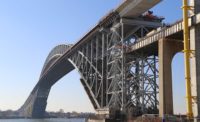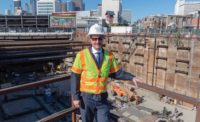After snaking through a subterranean obstacle course of utilities, foundations, methane gases and various urban structures, the 22-ft-diameter tunnel-boring machine (TBM) dubbed "Angeli" broke through to its termination point at Fourth and Flower streets in downtown Los Angeles on July 19. It marked a key milestone in the $1.7-billion, 1.9-mile Regional Connector project—the "missing link" that will connect existing rail lines for seamless rides throughout Los Angeles County.
Having completed the first of twin tunnels between Little Tokyo west to downtown in five months, Angeli will now be disassembled over the course of five weekends and brought back to the original launch site to begin the second tunnel this fall, says Gary Baker, project director with the Los Angeles County Metropolitan Transportation Authority (Metro). BIM-assisted design and Shape Accel Arrays—a system of wireless sensors—helped Angeli navigate through extremely tight tolerances and situations of very shallow cover.
Utilities Jungle
The tunneling is not even the toughest part of the job. "This is a utilities job," says Richard McLane, chief mechanical engineer with Regional Connector Constructors (RCC), a joint venture of Skanska USA Civil West California District Inc. and Traylor Bros. Inc. "Tunneling is about 6% of the total project."
Unexpectedly tough utilities challenges caused termination of an initial contract, and much of the remaining work was tacked on to RCC's contract as a change order in 2016. The utility issues pushed the completion back by about a year to 2021 and ramped up the project cost from $1.4 billion. "The real impact to the project was the condition of the utilities," says Baker. "The customary approach when constructing stations is to support the utilities from the roadway deck while excavating below. But the electrical utilities' condition in some old parts of town was unsafe for crews to handle. We had to relocate and replace them."
Construction sequencing also had to be restructured. "We were going to run the TBM through the cavern at Second Street and Broadway and then start mining again," says Derek Penrice, a vice president with Mott McDonald, RCC's designer. "We had to go back to square one" with design.
Instead of completely excavating the cavern for one of three stations, walking the TBM across it and then relaunching it, RCC decided just to tunnel through the area and go back to complete the second tunnel before completing the cavern, says Matt Antonelli, senior director of construction management with Metro.
That's also the case for a sequential-excavation-method cavern—290 ft long, 58 ft wide and 36 ft tall—that will eventually serve as a crossover structure over the tracks, says Baker.
When excavation of that cavern commences later in the project, "it will be one of the largest excavations in L.A.," says Penrice. "It will be in shallow cover underneath a storm drain and adjacent buildings."
Tight Spaces
Angeli launched out of a 45-ft-deep pit in Little Tokyo, burrowing through an initial 400 ft of alluvium above the water table and only 5 ft of earth above it, says McLane. "Generally, you want at least one tunnel diameter's worth above you. We had to supplement the low cover with soil backs to add more surcharge for the machine to tunnel under pressure. Then we had a 600-ft curve downslope. That was the roughest part."
After that, the TBM tunnels through the Fernando formation, a local bedrock that is "generally pretty good for tunneling," says McLane. But with only the one TBM, the team will have to repeat the initial launch through the shallow cover and alluvium.
The TBM also passes beneath the existing Red Line subway, past the historic Second Street Tunnel and close to batter piles for the Fourth Street Bridge. In one case, the team had to figure out how to avoid several layers of tiebacks supporting the Bank of America basement. "TBMs don't like to tunnel through steel," notes Penrice. The team changed the initial Metro plan to create a 100-ft-x-30-ft excavation, 70 ft deep, to cut out obstructive tiebacks.
"It would've been too disruptive to city traffic," says Penrice. "We came up with a scheme to use a more limited 26-ft-diameter shaft, created a 10-ft-diameter tunnel and cut the tiebacks."
BIM served as a useful tool to help designers size the shaft properly and excavate only as much as needed, says Penrice. "Then we filled the hole back up again with a low-strength material that the TBM could mine through."
Underneath downtown streets, conditions are so constrained that at one point the twin tunnels will be only 4 ft apart, notes Penrice. "Ideally, you would like a tunnel diameter's worth between them," he says.
The tunnel design utilizes three types of precast concrete-lining segments to accommodate different conditions, including depths of over 100 ft, shallower areas and a section of Little Tokyo that may undergo redevelopment and thus required extremely heavy lining, adds Penrice.
Monitoring Mission
A Shape Accel Array (SAA) proved instrumental in keeping Angeli on track as it passed under the shallow initial ground cover and through the dense web of underground infrastructure. A 400-ft-long array of accelerometers positioned just above the TBM measure movement and potential deformation or settlement, transmitting data to the team's command center. "It sends automatic alerts if something is out of tolerance," says McLane. Settlement generally must be no more than a half-inch.
The team also uses natural gas detectors to warn of naturally occurring methane gas. The danger of tunneling in Southern California is well-documented: 17 workers were killed in a methane explosion in a water tunnel in 1971, and another blast in 1985 destroyed a clothing store during the construction of Los Angeles' first subway system. "That put a halt to tunneling in L.A." for a while, says McLane.
However, only once so far has a sensor alert resulted in a daylong shutdown on this project, he says.
Angeli also has a history with Los Angeles, having built the Gold Line extension in the mid-2000s. The TBM then went to Seattle, building tunnels for the University Link light rail system. Each time, the TBM was reconfigured for each project's specific needs; for the Regional Connector, it needed to navigate a 550-ft curve, says McLane.
The 1,000-ton, 350-ft-long TBM, which got its current moniker from a contest held among Los Angeles schools, will excavate approximately 130,000 cu yd by the time it finishes early next year.
The project will allow commuters to travel between Long Beach to the south and Azusa to the north—about 40 miles—and between East Los Angeles and Santa Monica to the west with seamless transfers among the Blue, Gold, Red and Green lines. Metro expects that 90,000 daily trips will be taken on the new corridor.
Metro is aiming for a December 2021 completion of the project and is in the midst of negotiations with the contracting team to consolidate a number of milestones and phases, says Baker. "We are hopeful we can finish this project" before the December deadline, he adds.








Post a comment to this article
Report Abusive Comment